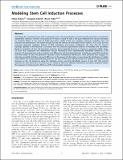Modeling Stem Cell Induction Processes
Author(s)
Gracio, Filipe; Cabral, Joaquim M. S.; Tidor, Bruce
DownloadGracio-2013-Modeling stem cell i.pdf (1.881Mb)
PUBLISHER_CC
Publisher with Creative Commons License
Creative Commons Attribution
Terms of use
Metadata
Show full item recordAbstract
Technology for converting human cells to pluripotent stem cell using induction processes has the potential to revolutionize regenerative medicine. However, the production of these so called iPS cells is still quite inefficient and may be dominated by stochastic effects. In this work we build mass-action models of the core regulatory elements controlling stem cell induction and maintenance. The models include not only the network of transcription factors NANOG, OCT4, SOX2, but also important epigenetic regulatory features of DNA methylation and histone modification. We show that the network topology reported in the literature is consistent with the observed experimental behavior of bistability and inducibility. Based on simulations of stem cell generation protocols, and in particular focusing on changes in epigenetic cellular states, we show that cooperative and independent reaction mechanisms have experimentally identifiable differences in the dynamics of reprogramming, and we analyze such differences and their biological basis. It had been argued that stochastic and elite models of stem cell generation represent distinct fundamental mechanisms. Work presented here suggests an alternative possibility that they represent differences in the amount of information we have about the distribution of cellular states before and during reprogramming protocols. We show further that unpredictability and variation in reprogramming decreases as the cell progresses along the induction process, and that identifiable groups of cells with elite-seeming behavior can come about by a stochastic process. Finally we show how different mechanisms and kinetic properties impact the prospects of improving the efficiency of iPS cell generation protocols.
Date issued
2013-05Department
Massachusetts Institute of Technology. Computer Science and Artificial Intelligence Laboratory; Massachusetts Institute of Technology. Department of Biological Engineering; Massachusetts Institute of Technology. Department of Electrical Engineering and Computer ScienceJournal
PLoS ONE
Publisher
Public Library of Science
Citation
Grácio, Filipe, Joaquim Cabral, and Bruce Tidor. Modeling Stem Cell Induction Processes. Edited by Rajasingh Johnson. PLoS ONE 8, no. 5 (May 8, 2013): e60240.
Version: Final published version
ISSN
1932-6203